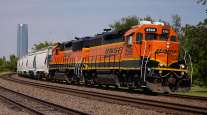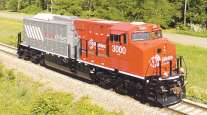FRA Proposes Keeping Two-Member Train Crew Size

The Federal Railroad Administration proposed broad new requirements that railroads run trains with two-member crews, saying that the already controversial proposal is justified in light of recent accidents in Canada and the United States.
“A minimum requirement of two crewmembers is proposed for all railroad operations, with exceptions proposed for those operations that FRA believes do not pose significant safety risks to railroad employees, the general public and the environment by using fewer than two-person crews,” the agency’s notice said.
The notice of proposed rulemaking, linked to the Canadian accident that killed 47 people and a derailment in North Dakota, drew immediate criticism from the Association of American Railroads, whose president Edward Hamberger called the plan “inexplicable”. On the other hand, Edward Wytkind, a spokesman for transport trade unions, commended the agency on “this long-overdue safety proposal."
The largest freight railroads today have two-member crews. U.S. freight railroads maintained that when positive train control technology is in place on 60,000 miles of key routes, that the safety technology will be effective enough that a second crew member is not needed. That technology, mandated in a 2008 law sparked by a fatal California commuter train wreck, won’t be required until 2020 since the freight railroads last year convinced Congress to extend a compliance deadline for five years. Smaller railroads that operate at lower speeds on shorter routes can run with one person in the locomotive.
“FRA proposes regulations establishing minimum requirements for the size of train crew staffs depending on the type of operation,” the agency’s notice of proposed rulemaking said. The agency offered two potential approaches for compliance if a carrier seeks to continue to use or begin operating trains with one crew member.
In both cases, a railroad that wants to continue an operation or starts a new one would have to describe its plans and provide safety information. Option one includes an agency review and approval period of up to 90 days, the notice said. Option two allows new or existing operations to continue while the review takes place, as long as a railroad operating executive certifies that adequate safety standards are in place.
“Coming from an administration that champions smart, data-driven regulations, it is inexplicable how this proposal was approved by the president’s Office of Management and Budget,” said Hamberger. “PTC is designed to provide continuous monitoring of train operations to protect against human error in controlling train speeds and movements. This is exactly the kind of safety redundancy through technology for which the FRA has long advocated.”
Wytkind said in the other statement issued on the same day as the proposal was announced that “among our concerns are the ill-advised provisions offered as an option in the rule which would permit one-person crew operations in certain circumstances. These measures are overly lenient and should be removed from the final rule.”
The agency’s proposal also said FRA was concerned that PTC and other technologies would be put in place with one person in the locomotive, “without considering safety risks or implementing risk-mitigating actions that FRA believes are necessary. Because there are currently few railroad operations that utilize a one-person crew and FRA has not been specifically tracking the safety of those operations through its recordkeeping and reporting requirements, FRA cannot provide reliable or conclusive statistical data to suggest whether one-person crew operations are generally safer or less safe than multiple-person crew operations.”
The agency also said that while there was no statistical safety evidence linked to crew size, there were “qualitative studies” that found a sole crew member could be impaired by performing too many tasks during train operation.
While there are no one-person crews on major freight railroads now, the concept has advanced to the point that BNSF Railway sought union approval to run trains on some main lines with just an engineer and the presence of a roving “master conductor” who could perform tasks such as train inspections or dropping off freight cars for multiple trains in a specific region. The proposal failed.




